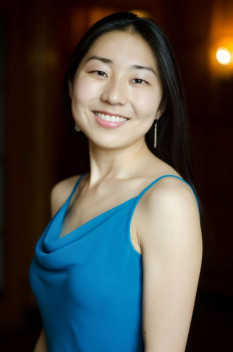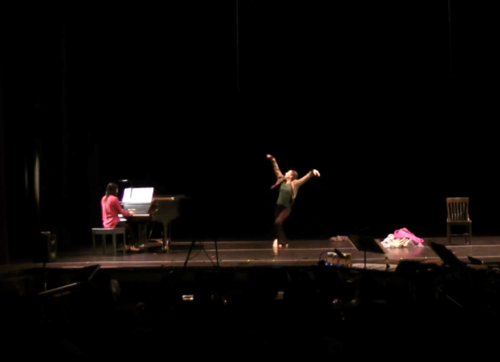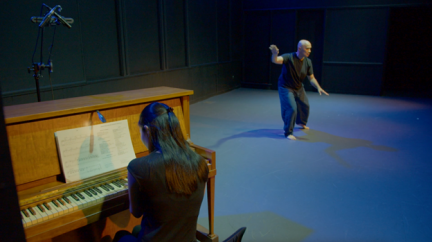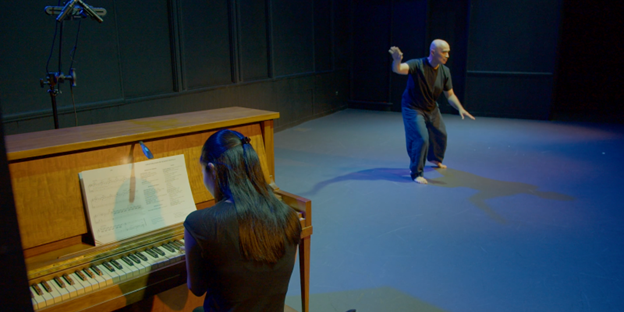
Yoshiko Arahata
Dr. Yoshiko Arahata ’11E, ’18E (DMA) is a concert pianist, collaborative pianist, chamber musician, educator, and composer currently based in Rochester, NY. To kick off the one week in-person portion of her Summer@Eastman program, “The Pianist’s Guide to Dance Accompaniment,” Dr. Arahata will be giving a faculty recital on Monday, July 19 at 7:30 p.m. in Hatch Hall. It will feature both concert solo and duo pieces, original music, and collaborations with dancers: Mariah Steele, UR Lecturer in Dance; Ruben Ornelas, professional dancer; and QuickSilver Dance company. Duo music will be performed with saxophonist Dr. Chisato Marling, a Vandoren Performing Artist.
This past week, Eastman Communications Office intern Rachel Richards was given the opportunity to interview Dr. Arahata about her upcoming recital.
In a previous article about your Summer@Eastman course, “The Pianist’s Guide to Dance Accompaniment”, you mentioned how your experience as a dance accompanist helped you grow tremendously as a musician. How have your collaborations with dancers affected the way you compose? Both for compositions that feature dance and those with more traditional instrumental orchestration?
Dancing has music inside too. When I see dancers, I hear music from their movement. Even if it’s just a simple rhythm first, I listen to their intention and create music for that movement. Really good dancers always have musicality to their dance. Some ballet teachers also tell students, you have to really show that you’re not just moving around, you’re showing the story, just like musicians. We’re not just playing the notes, right? We’re conveying something, expressing something. This very visual aspect of dance really made me think of what I want to do with each of my compositions; what is this piece trying to tell me, and what can I do to help convey this to the audience (visually) in the best way possible.
Right before my first dance accompanist job at Nazareth College, I gave a DMA lecture recital on the pedagogy of improvisation, which basically encouraged all classical musicians to start improvising. So I thought, okay, I have no excuse to not do that in my ballet accompaniment job. There’s no guide for this type of accompaniment, so I had to learn thorough experience. In that way, it was a very hands-on learning experience that helped me improve my improvisation, composition, and performance.

Yoshiko with Mariah Steele
In Monday night’s program, I saw there are many pieces that feature choreography by Mariah Steele. How did the two of you meet and start collaborating? What is it like composing and choreographing a piece simultaneously?
U of R is one of the places I have worked as a pianist for the dance classes. I got to work with the dance faculty and eventually started to compose music for dance shows they had with the students there. That’s how Mariah and I met and started collaborating.
As for composing and choreographing a piece simultaneously, it depends on how much choreography has been set. For Kaleidoscope, Mariah already had the choreography almost done. In that instance, it was a film scoring kind of process. Because she already had this very clear idea of what the overall visual part would be, I was supporting that with the music.
If the music is for a dance show, of course the dance choreographer takes more of a directing role; the choreography tends to come first, music after. So at times, I’m more of an accompanying role, which can sometimes feel restricting. I have to follow exactly what the choreographer wants; I can’t just do what I feel like is right for the music. But there’s a lot of communication, and in a way this visual foundation we have when scoring for dance and film makes it easier to start composing because you’re not starting from complete zero, and it’s also very fun to have something that you want to compose for. So it’s still a very rewarding experience. Also, there’s something so extremely special about each of us with different skills coming together and creating something together, production or piece you can only achieve as a team.
I think of improv as a type of variations on a theme, whether it’s a conceptual theme or something based on a musical rhythm or harmony. I also think of composing for dance as that. I still have freedom to do musical things but they depend on my interpretation of the dance and what I’ve learned of the choreographer’s intention in the process. For some other movements, Mariah had verbal or descriptive ideas, but she wasn’t sure what she wanted exactly with the movement. I improvised a lot in front of her, so she could try things out and experiment.
Can you tell us a bit about your program for Monday night’s concert? How do you go about programming concerts which feature dance works in combination with more traditional solo and duo works such as this one?
Honestly I feel like I kind of piled up what I felt like I wanted to play and then it became the full recital program. I did want to play a few solo and duo pieces that showed my purely music side as well. I wear different hats in different musical works I do, and I think this recital ended up being sort of a portrait of me as a musician. Starting off, I wanted to play this very short piece by a Japanese composer, Shin’ichirō Ikebe, partly because it sounds like a slow waltz. It’s something I played when I was very young, the first piece that I still remember performing. I don’t know why I came back to the piece, but I thought it would be a nice, pretty opening for the recital.
The next piece is a Toccata from Piano Sonata No. 1 by Ned Rorem. I think it’s a really exciting piece that not many people here play, at least around me. I learned about it when the NY Times had an article about Rorem, and there was a youtube video linked to that. It was a splendid performance of this Toccata by Thomas Lanners, who studied with Barry Snyder at Eastman years before me. What a coincidence, I thought. I love the hints of American Romanticism and jazz in this piece. And it’s fierce!
I recently got to work on Chopin’s Ballade No.1 with musicologist, Zbigniew Granat, and working with him helped me understand the ballade further. Chopin’s ballades also have dance elements inside; not every single section is a dance, but some parts are very dance-like, which I thought would be appropriate for this recital.

Yoshiko with Ruben Ornelas
The next piece is Ricardo Castillo’s Ocho Preludios Para Piano, a piece I have done with a professional dancer based in Rochester named Ruben Ornelas. He discovered this piece because he knew the granddaughter of the composer: a dancer, dance professor I believe, in Guatemala. It was my first time playing and learning about Guatemalan music, so that was really cool. I love the colors in this piece. Working with him, even though I was playing the music and he was doing the dance, I feel like he helped me look at the piece more deeply, and I’m grateful for that.
The last piece in the first half is Paul Hindemith’s Sonata for Alto Saxophone and Piano. I do a lot of collaborative piano as well in my music career. My upcoming job is also a very collab-heavy position at Indiana. The saxophonist Chisato Marling teaches at ECMS. We’ve been wanting to play together and it didn’t work out last time, but this time she was available. So I was like, okay, let’s do it!
The second half is entirely compositions that I have made in collaboration with dancer and choreographer Mariah Steele.
Kaleidoscope is an excerpt from a show that we did during the pandemic. Mariah specifically choreographed the dance for the Zoom screen, which I think is very cool. There are four sections for this piece. Kaleidoscope, the second section, is around five minutes long. There are so many things just happening; at one point we talked about the concept of reincarnation and the cycle of life, those sort of things.
ACTTCT/???/CAGTGG is about DNA modification and the ethics of it. Without giving away too much about the piece, it’s basically the potential consequences if we keep modifying genetics and produce human-made humans. Never have I imagined seeing a dance show about DNA or to compose for it. I love how Mariah selected this important 21st century topic to portray in dance.
My Life in Sweaters is about Mariah’s life. In the original choreography, she references some moments in her life with the 15 or so sweaters that she has: memories with people, trips, relationships with her family or friends, or her husband to-be who is now her husband. So it’s very intimate, raw, and sweet. For me, I took it almost like a combination of incidental music, piano suite, and musical theater. For this recital, I’m playing just the music by myself, in a piano suite manner. The original show had her dancing with the sweaters and reciting some texts, but we didn’t want the lack of those things to affect the audience’s perception of the music. We’re purposefully making the meaning of each movement vague so the audience can think about it and make their own conclusions.
Is there anything else you’d like to mention about your upcoming performance or any projects that you’re currently working on?
Dance accompaniment is something that might seem very new to some musicians. I think we see a lot of film music concerts, but I don’t think we have a lot of dance music concerts. And if I could do it, I know everyone else can too. Everything I have is everything I learned at Eastman and in other various parts of my life; I didn’t suddenly make this huge show. It started with little things I do. And after practicing that, it became easier for me to orchestrate and play around with my ideas.
So I feel like that process is always continuing and I hope the audience can just enjoy that, and will be able to see all of these influences in my compositions and in the other music that I perform.
Yoshiko Arahata presents “The Pianist’s Guide to Dance Accompaniment” on Monday, July 18 at 7:30 p.m. in Hatch Recital Hall. Tickets are $10.
